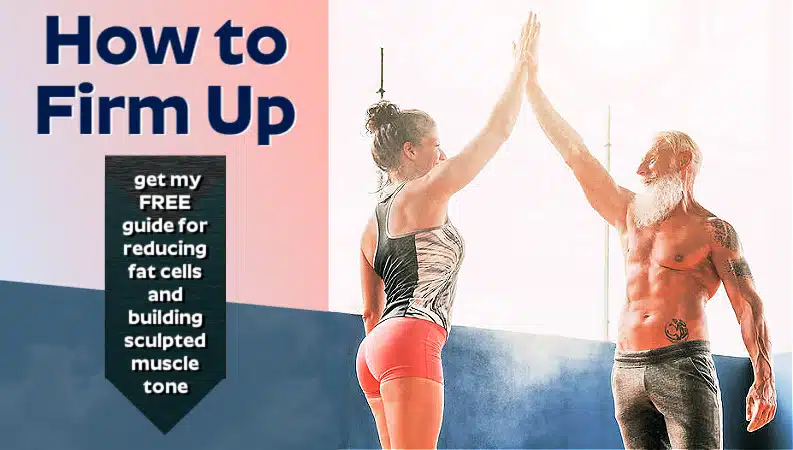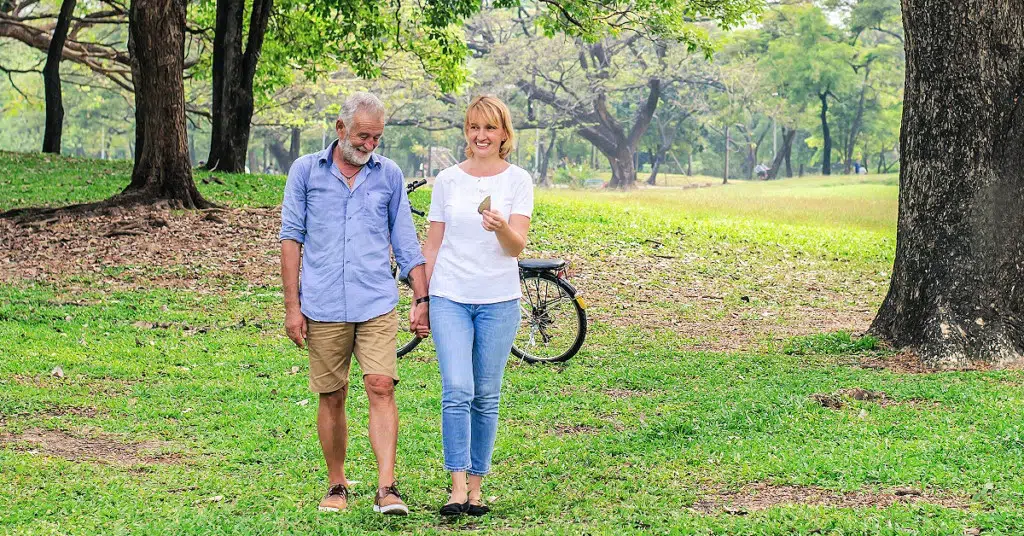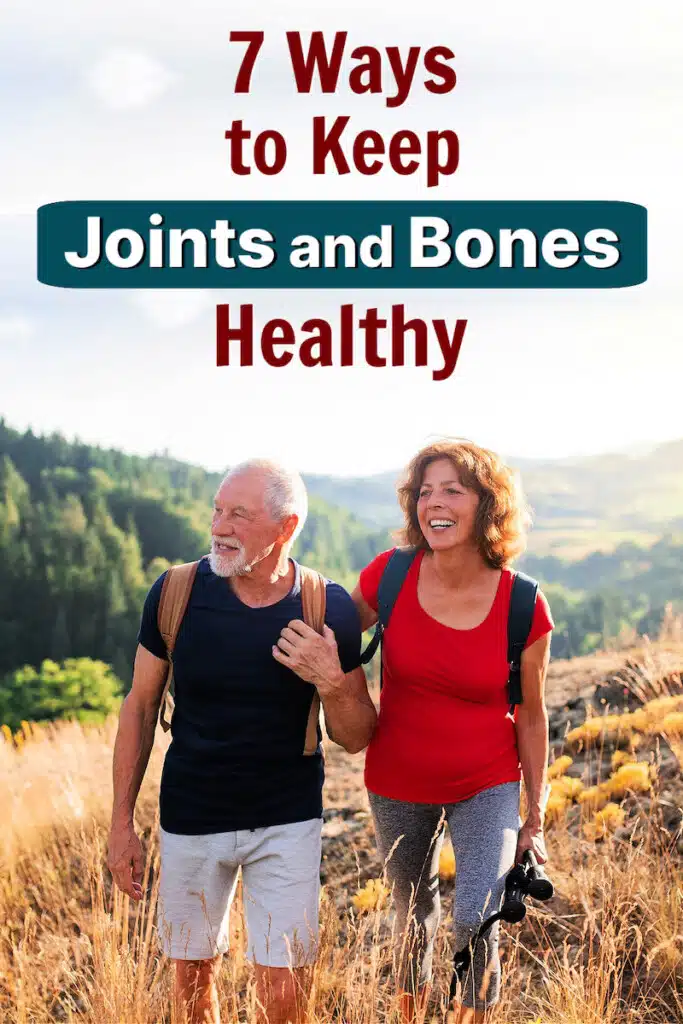Joints and bones can become problematic as you age. Joints can become stiffer, while bones can become weaker:
- Osteoarthritis is a degenerative condition, and rheumatoid arthritis is an autoimmune disease. Both cause stiff joints.
- Aging can impact bone health negatively, causing brittleness.
- It’s not unusual for people to have rheumatoid arthritis and osteoarthritis concurrently.
But getting older doesn’t mean you have to become arthritic or frail.
Below are 7 natural ways to keep your joints and bones strong and healthy.
Why Are Arthritis and Osteoporosis So Important to Address?
Osteoarthritis is a degenerative disease of the joints that occurs when the tissue at the end of bones begins to thin and roughen.
Rheumatoid arthritis is an autoimmune disease in which the body mistakingly attacks its own joints. Studies have demonstrated (see sources below) that people with rheumatoid arthritis have weaker bones.
Osteoporosis is a condition in which the human body loses old bone faster than it can create new bone – leading to bone weakness. This poses potential dangers, particularly to the hips, spine, wrists, and ankles.
All of these conditions can cause discomfort.
Over time, symptoms can get quite severe – causing misshapen hands and a lack of mobility throughout the entire body, especially in the neck, shoulders, lower back, knees, or hips – and increased risk for bone fractures.

Osteoarthritis, rheumatoid arthritis, and osteoporosis are among the most frequent causes of physical disability among older adults, increasing more rapidly after age 50.
How Aging Undermines Bone Healing (and what to do about it)
The process of bone healing slows down and becomes less effective with age.
Here’s why damaged bones heal more slowly in older people than in younger people:
It can take longer to heal from an injury as you get older.
- People over 50 – particularly women (see sources below this article) – tend to be at increased risk for developing osteoporosis, a condition characterized by thinning bones.
- Osteoporosis makes fractures more likely and affects the pace of healing. If you have osteoporosis or another condition affecting your bones — such as rheumatoid arthritis — you may not fully recover even with proper care and treatment.
The reason that bone healing takes so long in older people is that it involves several different processes working together in unison:
- The break in the bone must occur cleanly before any other work can begin.
- Blood vessels must form within each half of your injured limb.
- Cells, called osteoblasts, move into position on both sides of the fracture site; these cells then secrete substances that help repair damaged tissue and stimulate new blood vessels.
Osteoclasts – cells responsible for breaking down old bone tissue – complete their work so that all that remains is healthy tissue surrounding healthy blood vessels filled with healthy cells.
The immune system and bone marrow’s capacity for producing new cells decreases. Cells accumulate that have lost their ability to divide and grow correctly. This is called senescence.
Aging Impacts the Body’s Ability to Repair Each Bone
The immune system is a complex, interdependent network that protects the body from infections and illnesses. It consists of organs – such as the spleen and bone marrow – that produce white blood cells that fight viruses and bacteria.

The bone marrow is the soft tissue inside bones that produces blood cells to fight infection or injury. This process is called hematopoiesis (production of blood), which also produces platelets that help clot blood and red blood cells to deliver oxygen throughout your body.
Although it’s often overlooked, bone marrow plays a vital role in helping heal injuries and wounds by producing new cells when old ones are damaged by disease, injury, or aging — a process known as regeneration.
Senescent cells accumulate as we age. These do not divide like other cells, interrupting the regeneration of cartilage that protects joints and keeps bones moving smoothly.
As a result, bones do not repair themselves as well over time, putting older people at greater risk of osteoporosis — where they lose bone density.
When senescent cells accumulate, they produce proinflammatory cytokines that can harm healthy tissues. The accumulation of these senescent cells may weaken your body’s ability to heal itself and increase your risk of developing cardiovascular disease.
It’s no surprise that one of the most common causes of hip fractures is tripping or falling off stairs due to weakened bones.
However, it’s not just falling that can cause problems. Sitting for too long can adversely affect bone health because it restricts blood flow and limits movement needed for strong muscles and healthy joints — allowing senescent cells to build up.

Medical experts don’t yet fully understand why aging weakens the body’s ability to heal. More research is needed in this area, but there are a few factors that contribute to this phenomenon:
- As we age, our muscles lose mass and strength due to a decrease in lean body mass (the weight of everything other than fat). This reduces the force we can generate through muscle contraction and decreases our physical activity level — both of which play essential roles in bone healing.
- With age comes the deterioration of some tissues. Cartilage, tendons, ligaments, and scar tissue become less resilient over time — which means they may not be able to withstand compression forces like tearing or stretching during injury repair as well as they once did.
Stiff Joints and Weak Bones? Try These Methods to Help Reverse Symptoms
These evidence-based methods can help either reverse osteoarthritis and rheumatoid arthritis symptoms – including pain relief – or strengthen bones.
Take Avocado/Soybean Unsaponifiables for Better Joints
Avocado and soybean unsaponifiables (ASU) are extracts from avocados and soybean oil. Taking ASU (300-600 mg a day for 1.5 months or more) might slow the progression of osteoarthritis and rheumatoid arthritis while reducing pain and improving joint function.
Take Curcumin for Osteoarthritis and Rheumatoid Arthritis
Curcumin is the medicinal compound found within the root spice turmeric that is believed to protect cartilage and reduce pain and inflammation in human joints. Doses of 200 mg daily (for up to 3 months) were beneficial, especially if they came in a highly absorbable formula.
Exercise, Do Light Mobility Drills, and Stress-Relieving Techniques
Exercise helps your skeletal system.
Poor bone health leads to more bone being lost than replaced, causing a lessening in bone density. But adding intelligent exercise to your weekly routine can help build your bones back up.
Your doctor can tell you what your current bone density is. Over 200 million people currently have osteoporosis. About 1 in 3 women – and 1 in 5 men – over 50 will break a bone because of it.

Because we are all genetically unique (Up to 66% of differences in people’s bone mineral density may be attributed to genetics) and have different abilities to absorb sunlight and vitamin D supplements, you might find exercise a particularly effective way to strengthen your bones.
Better Movement = Better Bones
The types of exercise that probably support bone health are:
- high-impact anaerobic exercise (such as plyometrics)
- resistance exercise – with bands, springs, dumbells, barbells, kettlebells, or ankle weights
- steady-state cardio
Exercise in the form of stretching, Pilates, yoga, swimming, or mobility drills assists the synovial fluid in lubricating the joints:
- Synovial fluid is a thick gel in the human body that acts as a lubricant for joints. It reduces friction between bones and provides shock-absorbing properties, allowing for smooth and painless movement.
- The fluid is produced by the synovial membrane, which lines the joint capsule and is constantly replenished to maintain its lubricating properties.
By the way, the above forms of exercise provide the added benefit of helping the central nervous system to soothe and regulate.
Since exposure to cigarette smoke can dramatically exacerbate osteoarthritis symptoms, it’s important to find ways other than smoking and alcohol to soothe the central nervous system. Mindfulness meditation, visualization, and psychotherapy can also help improve one’s baseline of relaxation.
Take SAM-e for Osteoarthritis and Rheumatoid Arthritis
1200mg of the nutrient SAM-e was associated with significant improvements in joint pain and functionality after 30 days in adults with osteoarthritis. Secondarily, there have also been documented improvements in mood.
If you have highly sensitive skin, SAM-e might cause blemishes so a lower dosage could be appropriate. Each person responds differently. Ask your doctor first.
Try Topicals of Arnica, Capsaicin, or BioFreeze for Your Joints
For stiff or achy hands, some people have found arnica gel helpful.
Capsaicin or BioFreeze is better for lessening discomfort in the lower back or knees. These topicals don’t always work as well on hip pain because the hip joints are deeper inside the body and farther away from the skin.
Don’t use capsaicin or BioFreeze gel for your hands, as you might inadvertently touch your face or eyes – and that would sting (capsaicin is made from chili peppers).
Take Vitamin D for Osteoarthritis and Rheumatoid Arthritis
Research has established that people with significant osteoarthritis symptoms are usually also deficient in Vitamin D.
Vitamin D plays a role in bone health but has numerous other benefits. Adults can take anywhere from 1,000 to 4,000 IU daily, though many doctors recommend 5,000 IU. It depends partly on your body size and current diet.
Eat An Anti-Inflammatory Lifestyle Diet for Stronger Bones
Rheumatoid arthritis is an autoimmune disease, and therefore many people find eating an anti-inflammatory diet extremely helpful for reducing symptoms.
In the case of osteoarthritis, even though it’s not technically an autoimmune condition, an anti-inflammatory diet can still help osteoarthritis symptoms indirectly because the diet helps to improve cellular health, which, in turn, helps everything else.
An anti-inflammatory diet seeks to remove irritants from your daily menu and so consists mostly of vegetables and lean meats.
The genius of an anti-inflammatory diet is that it helps improve cellular health. When you improve your cellular health, you’re helping your entire body improve at its most fundamental source.
In other words, when your cells are operating perfectly, everything else is healthier as a result, including your skeletal system.
An anti-inflammatory diet is typically abundant in vegetables yet avoids any foods your body finds irritating.
What foods create a negative sensitivity is different for each person – but for many – flour, sugar, peanuts, nightshades, seed oils, fried foods, alcohol, and highly processed foods are typical culprits.
Another chief characteristic of an anti-inflammatory diet is that you can eat quality protein and complex carbohydrates; however, how much of these macronutrients you consume depends specifically on your current level of physical activity.
An anti-inflammatory diet is also beneficial for bone health because its typical menu tends to be higher in those micronutrients that directly assist the human bone – calcium, magnesium, vitamin D, vitamin K, and Omega-3.
It’s helpful to remember that each human bone is alive. Every day, old bone cells are replaced with new bone cells.
The human bone is designed to support the human body, protect its vital organs, and make it mobile.
However, the human bone is also a storage tank for some essential minerals. That’s why – though fresh air, sunlight, and an anti-inflammatory diet go a long way toward improving bone health – you might also choose to take supplements as an insurance policy against micronutrient deficiency that could harm bone health.
Engage Common Sense Tactics on Behalf of Your Joints and Bones
So many health interventions are common sense – avoid cigarettes, have very little alcohol, improve sleep, and reduce stress and negative thinking patterns.
Many people know that tripping and falling are common in seniors and can have devastating effects. But, in reality, people of all ages fall or faint more often than is commonly believed.
When a skull or wrist hits a wall or floor – it’s a moment of truth. Because that’s the exact second that you want your bone health to be as excellent as possible.
If osteoporosis runs in your family, you might consider consulting with your medical doctor now and getting your bone mineral density (BMD) tested so that you have a baseline from which you can monitor your bone health from this point forward as you age.
Conclusion on Healthy Joints and Bones
The health of our bones and joints is vital as we age because degenerative conditions such as osteoarthritis, autoimmune diseases like rheumatoid arthritis, and conditions like osteoporosis can cause stiff joints and weak bones.
These can lead to physical disability and an increased risk of fractures.
While aging can weaken the body’s ability to repair bones, there are natural ways to keep your joints and bones strong and healthy.
Taking care of your bones and joints through exercise and diet is crucial to keep them functioning smoothly as you age.
Further research is needed to fully understand why aging weakens the body’s ability to heal, but it is clear that taking care of our bodies and promoting healthy habits can greatly impact our overall health and well-being.
Additional Resources on Joints and Bones:
National Institute on Aging – https://www.nia.nih.gov/health/osteoarthritis
Bones and Arthritis – https://www.bones.nih.gov/health-info/bone/osteoporosis/conditions-behaviors/osteoporosis-ra
ASU Supplementation – https://pubmed.ncbi.nlm.nih.gov/9433873/
Benefits of Turmeric – https://examine.com/supplements/curcumin/
SAM-e and Osteoarthritis – https://examine.com/rubric/effects/view/627b48d497f10335487c6a01bbeb8720/846e9c6e95a32a8d804f103ffdde3f80/all/
Osteoarthritis Interventions – https://www.rheumatology.org/Portals/0/Files/Osteoarthritis-Guideline-Early-View-2019.pdf
Top-Up Your Vitamin D Levels – https://examine.com/supplements/vitamin-d/
Examine.com – a very helpful website that looks at entire collections of research studies on specific health topics and analyzes their scientific validity – https://examine.com/
SelfDecode.com – a website that is excellent at helping you understand your own genetics and how you can turn the dial “up” or “down” on specific genes – https://selfdecode.com/
Osteoporosis in Women – https://www.webmd.com/menopause/guide/osteoporosis-menopause
Calcium and Other Nutrients for Skeletal System – https://www.ncbi.nlm.nih.gov/books/NBK109817/
Impact of Resistance Training on Bone Density – https://pubmed.ncbi.nlm.nih.gov/9927006/
